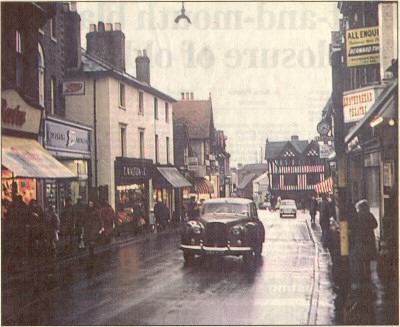Leatherhead AHEAD
- from the Archives
Countdown to 'death of the
town'
by Rob Ditcham and Beth
McLoughlin
Leatherhead Advertiser 2002
The
bustling town shown in the picture is little more than a
fond memory for many Leatherhead residents.
It is a town packed with
busy shops, with crowded pavements and, more importantly,
with a traffic-filled High Street. The new campaign group
Leatherhead Ahead is committed to restoring a currently
pedestrianised town to this scene from 1965*. But the group, which includes
local residents and traders, highlights a major obstacle
to its ultimate aim - the proposed new water feature
which is just 11 days away from being started.
|

Through traffic: Leatherhead High Street in 1965 |
Although it has been told the
development is aimed at improving access to the High Street for
wheelchair-bound people and as a sensory feature, campaigners
believe it will lead to the ultimate death of the town. They
claim the only way to breathe fresh life into Leatherhead and
attract more shops and leisure facilities is to allow traffic to
flow between High Street, Bridge Street, North Street and Church
Street.
Local resident and campaign member
Lin Friedstad said: "The town was built on the crossroads in
the centre of the town. They are the arteries which feed the
heart and they must be allowed to flow again." Peter Austin,
owner of High Street furniture shop Pimms, added: "When the
water feature is in place that will be the end of Leatherhead.
The only way the town can be saved is if the crossroads are
reopened to traffic. We thought this would happen when the Clock
Tower was removed but now another obstacle is being put there.
The main thing a town needs is access. People must be able to get
into a town or it dies. Since Leatherhead was pedestrianised, 80
shops have left the town."
Mr Austin admitted the road is
narrow but said Bookham High Street is wide enough for one-way
traffic so Leatherhead should be as well. A 1997 survey prepared
for town traders, many of whom are now part of Leatherhead Ahead,
concluded that local residents wanted more car parking spaces,
lower parking charges and easier access to the town centre.
Parker Tanner, the market research consultants which carried out
the survey, came to this conclusion after discovering that 84 per
cent of those questioned used their cars when travelling to the
town centre.
Leatherhead Ahead campaigners also
highlighted a document produced in 1994 called the Mole Valley
Local Plan Consultation Draft, which outlined highways options
for Leatherhead. The document said the exclusion of traffic from
Church Street and High Street were seen to reduce the level of
activity in the town centre and public awareness of its shopping
facilities. Councillor Hubert Carr (Lib Dem, Leatherhead North)
argued in favour of a pedestrianised High Street but said it must
be complemented by good access and parking around it.
Councillor Rosemary Dickson (Con,
Leatherhead South) said she had been in favour of reopening the
road to traffic but was told by highways experts at Surrey County
Council that this would reduce road safety. Even Sir Paul
Beresford campaigned for an end to pedestrianisation when he
first became Mole Valley's MP, while town centre manager Peter
Stait admitted that the town is paying the price for what
happened in the 1980s.
But they stressed that the main
voice when the decision over pedestrianisation was taken was in
favour of banning traffic from the High Street. And they maintain
people's views on the water feature and traffic in the High
Street should have been clearer during the official phase two
consultation period in 1999.
* In fact we have never supported the reintroduction of two-way
traffic in the High Street, but do favour time limited one way
access to the High Street, with short stay parking slots clearly
marked and the ‘highway’ clearly delineated throughout,
as a means of improving parking and access, and visibility of the
shopping area.
